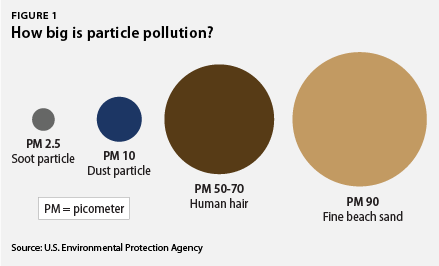Soot (also known as Black Carbon): “ a type of particle pollution called PM2.5, which is approximately 1/30 of the size of a human hair. It is comprised of a variety of pollutants, including chemicals, acids, metals and dusts, etc. It results from the incomplete combustion of hydrocarbons.”
The Journal of Geophysical Research: Atmospheres recently released a report stating that soot is twice as damaging for the climate as most have previously expected. According to the UNEP study results, soot is the second most damaging greenhouse agent after carbon dioxide. Soot currently has a global warming effect of approximately 1.1 watts per meter square, which is only 0.6 watts per meter square lower than carbon dioxide. Furthermore, black carbon causes more harm to cold and frozen regions; for the amount of light, and heat absorbed is increased when soot falls on snow or ice. This means that the effect of soot is more apparent in the high latitudes areas such as northern Canada, and Alaska, etc. However, experts claim that the biggest impact of black carbon is on health rather than on the climate, as it causes tremendous harms to the human body, such as lung and other diseases. Study results show that controlling black carbon emission could save up to 2.5 millions of lives a year.
While the new study results show that black carbon is the main cause to several environmental and health problems, it is still easier to reduce soot than carbon dioxide. First of all, as an inevitable by product of fossil fuel, carbon dioxide is long lasting, whereas black carbon only stays in the atmosphere for a few weeks. As long as new soot is not emitted, the existing soot will eventually dissipate. Hence, it is cheaper to cut soot than carbon dioxide. Also, global agreement is not needed for abating black carbon, and it mainly benefits the locals, free riders do not exist in this case. The author of the study argues that if people did their best at reducing soot emission, global warming would be slowed down significantly.
Personally, I still see carbon dioxide emission as the leading cause to the acceleration of global warming. Indeed, the study has found useful results regarding the negative effects of soot emission, and it is clear that reducing black carbon emission improves human health, and reduces environmental damages. However, from the environmental perspective, a larger proportion of effort and time should be put into cutting carbon dioxide reduction when the goal is to decelerate global warming.
Reference:
http://www.americanprogress.org/issues/green/news/2012/08/10/12007/soot-pollution-101/

12 replies on “Soot Pollution 101”
Well-researched blog entry! Although, a lot of it is well documented you did a good job of incorporating visuals to elucidate your point. Another thing that you do really well is talk about emissions/ abatement costs, policy,and public perception in the same blog entry. You have kept all of it brief which is effective. Perhaps, another factor that you may have mentioned here would have been the current targets that the countries have set in global treaties to curb the emission levels of carbon.
In conclusion, a nice effort and well written!
Thank you for the suggestion, Ahmed! Regarding the current targets that countries have set to curb the black carbon emission, the U.S. is projected to reduce black carbon emission by 86% by 2013. See the link below for details: http://www.epa.gov/blackcarbon/mitigation.html
Nice Blog!!!
I didn’t know that soot is the second most damaging greenhouse agent after carbon dioxide. I think this is really good for people who know that carbon dioxide is only one causing global warming effect. Thanks for sharing information!! 🙂
Hey Cindy! That’s news to me too.. according to the study, carbon dioxide has a warming effect of 1.7 watts/sq meter, and soot has an effect of 1.1 watts/sq meter, which means the difference between the 2 is only 0.6 watts/sq meter. Also, soot’s warming effect is currently higher than that of methane’s!
Good new knowledge! I am looking forward to more information such as policy, the cost of eliminating this pollution. Thanks for sharing!!
Nice point. It is effective to curtail the soot exploration to decrease the emission of carbon dioxide.
Thanks for the comment, Iris! I’m not sure if reducing soot can lead to reducing carbon dioxide emission directly, but the actions that we take to reduce soot emission are most likely going to help with the reduction of carbon dioxide..
It’s also new to me. Thanks for sharing!
It somehow made me think of the GM and Nanotech pollution in food, when you compared the CO2 and Soot pollution in air. haha
Here’s an article about nano particles in our food, if interested. http://grist.org/food/nanoparticles-in-your-food-youre-already-eating-them/
Thanks for the article, Roson! It’s interesting how you are comparing the GM and Nanotechnology pollution in food with carbon dioxide and black carbon pollution in air, but you are right.. there are definitely some similarities between the them!
nice blog!
thank you for sharing information about soot!
I have not known what soot is before.
it seems that it is too cheap to clean soot.
but if it is one of leading factors of global warming, i think government should internven to protect environment like taxation.
Hey, Elly,
It is relatively inexpensive to reduce black carbon. However, effort is still needed to prevent new black carbon from emitted.
Great explaination about PM 2.5. The pollution in Beijing is the most popular topic this week. I feel really sad about it~ The most effective way is that we should limit the industrial emission, through tax or quota:-)